Thunderbolt: Difference between revisions
m (Reverted edits by 172.69.67.145 (talk) to last revision by Mrboojay) Tag: Rollback |
No edit summary |
||
| (8 intermediate revisions by 2 users not shown) | |||
| Line 1: | Line 1: | ||
{{Infobox siren | {{Infobox siren|image=Thunderbolt 1000T.png|company=[[Federal Signal Corporation]]|title=Thunderbolt|produced=1952-1990/1992?|type=<div>[[Rotational]] [[Electromechanical]] (Model 1000, Model 1000T, Model 1003, System 7000) | ||
|image = | <div>[[Rotational]] [[Electromechanical]]/[[Gasoline-Driven]] (Type 2000)|output=125-130 dB @ 100 ft|hz=60|hp=2 hp|voltage=120/240/480|current=1 or 3 ph|succeeded=<div>[[Federal Signal 2001]] | ||
|company= [[Federal Signal Corporation]] | <div>[[Federal Signal 508-128]]|blower=7.5 hp|manual=https://drive.google.com/file/d/16ayS7epmZoaAggjyCQKGHu1jaHXmn3VZ/view?usp=sharing|caption=A privately owned Thunderbolt Model 1000T on display, complete with controls and 4M blower.}}The '''Thunderbolt''' was a long-running Series of supercharged rotating sirens manufactured by [[:Category:Federal Signal Corporation|Federal Signal]], and over its nearly 40-year production run it gained a reputation as one of the most popular civil defense sirens ever produced, sporting nearly unrivaled sound output when it was released, and continuing to be an incredibly popular siren until its discontinuation. | ||
|produced=1952-1990 | |||
|type=[[Electromechanical]] | |||
| | |||
|voltage= | |||
| | |||
|succeeded=[[ | |||
[[ | |||
The '''Thunderbolt''' | |||
== History == | |||
Federal Enterprises began production of the Thunderbolt Type 1000, a supercharged electromechanical rotating siren, in 1952. While most sirens are run on their own using air from the intake, the Thunderbolt was unique at the time for making use of a "Type 6M" supercharger in the form of a belt-driven Roots blower, which was changed many times throughout the siren's production. This would feed compressed air into the chopper, massively increasing the siren's sound output. This idea would be copied by [[Alerting Communicators of America|ACA]] in 1968, with the introduction of their supercharged [[ACA Hurricane 130|Hurricane 130]]. Contrary to popular belief, Federal never sued ACA for their similar design. The Model 2000 was released later in 1952 as a gas-powered variant of the Type 1000. While it was a good idea in concept, it was never popular due to the increased maintenance the engine required over a basic electric motor. Grid power was also widely available by the time the siren had released. They were mainly installed around California and Arizona. Due to the increased maintenance required as well as the impracticality of operating gasoline powered sirens today, only a few units remain, none operating on their engines. 2 of the surviving units were converted to electric motors for the blower, with one being in Phoenix, Arizona at Fire Station 22, and the other located at a school in Beebe, Arkansas, replacing a Whelen Engineering [[Whelen WPS-4000|VORTEXR4]] in 2019 that was struck and fried by lightning. | |||
It is the last active Type 2000, although it is essentially now a Type 1000. There is only a single known Type 2000 with its original engine intact, which is located in Windsor Hills, CA. It was converted to propane at some point and is inactive and dilapidated like most of California's former civil defense siren systems. In 1954, the Model 2000 was discontinued, the "jail bar" horn reinforcements on Thunderbolt sirens were removed, and the Type 1000T was introduced. The Type 1000T originally used the 4/5-port dual tone rotor from a Model 2T; by 1959 5/6-port dual tone became the standard, with 4/5 being discontinued shortly after. Single-tone Thunderbolt sirens became known as the Type 1000. The Type 1000T became the standard model of Thunderbolt upon introduction, with the Type 1000 becoming optional. The Type 1000T was intended for civil defense purposes, while the Type 1000 was switched to being used for other purposes, though it could still be used as a civil defense siren if necessary. In 1959, the Type 1000 and Type 1000T began Series A2, a new Type 5M blower model was introduced, and Federal Signal introduced a 3-signal model known as the Type 1003. These were mainly meant for use in fire stations where the hi-lo signal would be used to separately warn of fire calls, since using the attack signal could cause confusion and panic. | |||
The | The Type 1003 effectively replaced the Type 1000 for this purpose. The Type 4M blower began production in 1965, replacing the Type 5M. The Type 4M was created in an attempt to make the blower cheaper to produce, at the expense of sound output. All Thunderbolt nomenclature replaced "Type" with "Model" in 1975 when Federal Sign & Signal became Federal Signal. In 1981, Federal began Series B of the Thunderbolt sirens with a complete rotator overhaul in an attempt to make the sirens more maintenance-free. The Series B Thunderbolt sirens did not last long in production, as they ironically were less reliable than the standard models due to alignment problems burning the motors. In 1982, System 7000 was introduced, a line of self-contained versions of the Thunderbolt intended for use in areas where reliable power was unavailable like war zones or remote areas, and the Series B and Series B Model 4M blowers were discontinued and replaced by the Series C Thunderbolt models with new Series C Model 4M blowers (though the Series C Thunderbolt sirens commonly suffered from build quality issues). The latest Series B Thunderbolt sirens also made use of Series C blowers. The System 7000 sold very few units, most System 7026 units purchased by Kuwait during the Gulf War that have since been replaced by Federal Signal [[Federal Signal Modulator|Modulator]] electronic sirens, some of which are mounted on top of the old enclosures. 1 System 7026 unit is confirmed to still exist, on display at the Kuwait National Office of Civil Defense. [[File:Thunderbolt Exploded View and Parts List.jpeg|thumb|An exploded view and parts list of the Thunderbolt.|160x160px]] | ||
In 1990, the Thunderbolt siren would finally be eliminated from Federal Signal's product line after a 38-year production run, as Federal's then-new [[Federal Signal 2001|2001-SRN]] outperformed it without the need of a blower and also boasted a DC motor and battery backup capabilities. The last Thunderbolt sirens to be manufactured were a batch of Series C Model 1003 sirens sent to Michigan, though they have since been removed. Supposedly, there was a single year run in 1992 where Thunderbolt sirens were manufactured with a slightly shortened blower frame/cover; no known 1992 models are known to exist, and this information is unverifiable. The Thunderbolt is perhaps the most well-known of any American civil defense sirens, even with non-enthusiasts unfamiliar with sirens. Despite the Thunderbolt line's discontinuation, elements of its design still remain in Federal's 2001 Series and the [[Federal Signal 508-128|508-128]] siren, with the 2001-SRN making use of the Thunderbolt rotator, and even today the collector ring tube from the Thunderbolt is still used in Federal's sirens even 30 years later. Many Thunderbolt sirens are still in service today, and while some have since been replaced by newer DC-capable sirens, many still continue to warn the public of danger. | |||
== Siren design == | |||
== | === Model 1000 === | ||
[[File:Jonesboro 1000.jpg|thumb|160x160px|An active Thunderbolt Model 1000 in Jonesboro, GA. Photo taken by Christopher J. (Trainsandsirens1)]] | |||
The ''Model 1000'' (''Type 1000'' before 1975) is a single-tone, 2 signal supercharged electromechanical rotating siren. The Model 1000 utilizes a 2-piece cylindrical pivotal point which encloses the motor and rotor and supports the siren's large exponential horn alongside 2 supports attached below the motor tube (bottom piece). The siren's stator and motor are reused from the [[Federal Signal Model 2|Model 2]]-240. Rather than using a typical stator, the Model 1000 makes use of a stator cap (upper piece) with a single port opening where the horn attaches to, focusing all of the siren's output through that port. Some of the earliest Type 1000 sirens came with a pressure release valve above the stator cap or downwards facing horns and an elongate stator cap. Early production Type 1000 sirens had 3 sets of steel reinforcements inside of the horn added by Federal Enterprises (nicknamed "jail bar" or "grid face" Thunderbolts by enthusiasts) as they feared the horn would warp and ruin the siren's sound output. A mesh screen was added inside the horn around 1953 to keep debris out and prevent the motor from burning. Federal experimented with horns that lacked the horn reinforcements, and the older horns were later discontinued in 1954 as the assembly without the reinforcements proved more than strong enough. | |||
[[File:Prototype Thunderbolt.png|left|thumb|160x160px|An earlier pre-production Thunderbolt undergoing competitive testing in Jefferson City, MO in 1951. A Model 2 and a H.O.R. Super Sirex are visible in the background.]] | |||
[[File:Jailbar 1000.jpg|thumb|160x160px|Many early Thunderbolt sirens were painted in a black and yellow color scheme (nicknamed the "Bumblebolt" color scheme) like this inactive Model 1000 with horn reinforcements in Knoxville, TN. Photo taken by Christopher J. (Trainsandsirens1)]] | |||
The siren's horn and rotor assembly are rotated using a belt-driven rotator inside of the box underneath the chopper tube, with collector rings inside the rotator allowing the siren to rotate 360°. The rotator is adjustable, with 3 different speeds: 2 rpm, 4 rpm, and 8 rpm. The vast majority of Model 1000 sirens are set to 2 rpm, with 4 rpm also being common while 8 rpm is much less common. Model 1000 sirens produced between 1981 and 1982 (Series B) use a motor turned 90 degrees to face the gear reducer coupled directly to the gear reducer instead of using a motor to drive a belt connected to a gear reducer to drive the rotator. These sirens could only rotate at 4 rpm, with the speed no longer being adjustable. These changes required the rotator box to be enlarged and offset from the siren's horn instead of being directly in the middle underneath and necessitated the use of external wiring to the chopper motor. The chopper motor itself was placed inside of a cylindrical cover. Series B was superseded by Series C in 1982, which returned to the previous belt-driven rotator and the previous unenclosed universal motor. | |||
[[File:Minneapolis proto thunderbolt.jpg|left|thumb|198x198px|A later pre-production Thunderbolt with a pressure release valve being demonstrated in Minneapolis, MN in 1952.]] | |||
These Series C models often suffered from issues stemming from poor build quality. The Model 1000 came in 1 and 3 ph variants, the Model 1000B and Model 1000A respectively. The Model 1000 is supercharged with what is known as a Roots blower. A Roots blower has 2 sets of lobes inside of a steel container (which is perfectly rectangular on production models, although earlier variants of the siren used rounded containers) which compress and supercharge the air flowing into it as they spin against one another, which is then piped up into the siren itself, massively increasing the siren's volume and range. These blowers were produced by Sutorbilt. The blowers take in air from above through a dedicated intake, and the lobes are driven by 3 belts and a 1 or 3 ph 7.5 hp electric motor. The siren's main pipe includes a pressure release valve beside the blower; this helps prevent the air pressure from blowing holes in the standpipe, destroying the chopper, or potentially exploding in the event of a blockage. A Model 1000 without a blower is effectively a Model 2 with a horn attached and inferior airflow, and as such Model 1000 sirens are quiet and high pitched without them. | |||
Blowers are only designed to spin one way, and if wired backwards (reverse wiring, possible on 3 ph Model 1000A sirens only) the blower will run in reverse, sucking air from the siren's horn and out of the blower. This results in the siren becoming very high pitched, and the blower becomes significantly louder, often nearly drowning out the siren itself because of this. This also causes the siren to have a near nonexistent winddown, as the air pressure causes the chopper to quickly come to a stop when the motor shuts off, and a slow extended windup as the chopper fights the airflow. The Model 1000 reaches 126 dB at 100 ft according to Federal Signal; however, the decibel rating of these sirens varies depending on the blower used. Typically, the higher air pressure created by the blower, the louder the siren will be. | |||
=== Model 1000T === | |||
[[File:Palm Springs 1000T.jpg|thumb|160x160px|An inactive Thunderbolt Model 1000T in Palm Springs, CA. Photo taken by CaliSirens00.]] | |||
=== | The ''Model 1000T'' (''Type 1000T'' before 1975) is a dual-tone, 2 signal supercharged electromechanical rotating siren. The Model 1000T utilizes a 2-piece cylindrical pivotal point which encloses the motor and rotor and supports the siren's large exponential horn alongside 2 supports attached below the motor tube (bottom piece). The siren's stator and motor are reused from either the 4/5-port or 5/6-port [[Federal Signal Model 2|Model 2T]]-240. Rather than using a typical stator, the Model 1000T makes use of a stator cap (upper piece) with a single port opening where the horn attaches to, focusing all of the siren's output through that port. The siren's horn and rotor assembly are rotated using a belt-driven rotator inside of the box underneath the chopper tube, with collector rings inside the rotator allowing the siren to rotate 360°. The rotator is adjustable, with 3 different speeds: 2 rpm, 4 rpm, and 8 rpm. The vast majority of Model 1000T sirens are set to 2 rpm, with 4 rpm also being common while 8 rpm is much less common. Model 1000T sirens produced between 1981 and 1982 (Series B) use a motor turned 90 degrees to face the gear reducer coupled directly to the gear reducer instead of using a motor to drive a belt connected to a gear reducer to drive the rotator. These sirens could only rotate at 4 rpm, with the speed no longer being adjustable. | ||
[[File: | [[File:Series B Thunderbolt.jpg|left|thumb|213x213px|A Series B Thunderbolt Model 1000T in Harper Woods, MI. It has since been replaced by a Federal Signal Model 2001-130. Photo taken by Eric L.]] | ||
The ''' | These changes required the rotator box to be enlarged and offset from the siren's horn instead of being directly in the middle underneath and necessitated the use of external wiring to the chopper motor. The chopper motor itself was placed inside of a cylindrical cover. Series B was superseded by Series C in 1982, which returned to the previous belt-driven rotator and the previous unenclosed universal motor. These Series C models often suffered from issues stemming from poor build quality. The Model 1000T came in 1 and 3 ph variants, the Model 1000BT and Model 1000AT respectively. The Model 1000T is supercharged with what is known as a Roots blower. A Roots blower has 2 sets of lobes inside of a steel container (which is perfectly rectangular on production models, although earlier variants of the siren used rounded containers) which compress and supercharge the air flowing into it as they spin against one another, which is then piped up into the siren itself, massively increasing the siren's volume and range. These blowers were produced by Sutorbilt. The blowers take in air from above through a dedicated intake, and the lobes are driven by 3 belts and a 1 or 3 ph 7.5 hp electric motor. | ||
[[File:Series B rotator.png|thumb|160x160px|The internals of a Series B Thunderbolt Model 1000T rotator.]] | |||
The siren's main pipe includes a pressure release valve beside the blower; this helps prevent the air pressure from blowing holes in the standpipe, destroying the chopper, or potentially exploding in the event of a blockage. A Model 1000T without a blower is effectively a Model 2T with a horn attached and inferior airflow, and as such Model 1000T sirens are quiet and high pitched without them. Blowers are only designed to spin one way, and if wired backwards (reverse wiring, possible on 3 ph Model 1000AT sirens only) the blower will run in reverse, sucking air from the siren's horn and out of the blower. This results in the siren becoming very high pitched, and the blower becomes significantly louder, often nearly drowning out the siren itself because of this. This also causes the siren to have a near nonexistent winddown, as the air pressure causes the chopper to quickly come to a stop when the motor shuts off, and a slow extended windup as the chopper fights the airflow. The Model 1000T reaches 124 dB at 100 ft according to Federal Signal; however, the decibel rating of these sirens varies depending on the blower used. Typically, the higher air pressure created by the blower, the louder the siren will be. | |||
[[File: | |||
The | |||
=== Model 1003 === | |||
[[File:Greenwood 1003.jpg|thumb|160x160px|An inactive Thunderbolt Model 1003 in Greenwood, SC. Photo taken by Christopher J. (Trainsandsirens1)]] | |||
The ''Model 1003'' (''Type 1003'' before 1975) is a dual-tone, 3 signal supercharged electromechanical rotating siren. The Model 1003 utilizes a 2-piece cylindrical pivotal point which encloses the motor and rotor and supports the siren's large exponential horn alongside 2 supports attached below the motor tube (bottom piece). The siren's stator and motor are reused from either the 4/5-port or 5/6-port [[Federal Signal Model 2|Model 2]]-240. Rather than using a typical stator, the Model 1003 makes use of a stator cap (upper piece) with a single port opening where the horn attaches to, focusing all of the siren's output through that port. The Model 1003 utilizes a solenoid operated mechanism in front of the stator cap which blocks 1 of the 2 ports in the horn—or both if desired—allowing for the siren to perform a "hi-lo" or "pulse" signal. The Model 1003 horn is slightly elongated and moved forwards to make way for the solenoid mechanisms. The return springs on the solenoids are prone to failure, with many units suffering from one or both solenoids failing to operate due to the springs wearing out. The siren's horn and rotor assembly are rotated using a belt-driven rotator inside of the box underneath the chopper tube, with collector rings inside the rotator allowing the siren to rotate 360°. The rotator is adjustable, with 3 different speeds: 2 rpm, 4 rpm, and 8 rpm. The vast majority of Model 1003 sirens are set to 2 rpm, with 4 rpm also being common while 8 rpm is much less common. The rotator box on the Model 1003 is enlarged to make room for the additional collector rings that were needed to run the solenoids. Also included with the Model 1003 would be a specialized Model RCM3 controller, which allowed for individual control of all components. Model 1003 sirens produced between 1981 and 1982 (Series B) use a motor turned 90 degrees to face the gear reducer coupled directly to the gear reducer instead of using a motor to drive a belt connected to a gear reducer to drive the rotator. | |||
[[File:Series B chopper.png|left|thumb|213x213px|The motor and chopper from a Series B Thunderbolt Model 1003, showing the enclosed universal motor.]] | |||
[[File:1003 solenoids.png|thumb|160x160px|The workings of a Model 10003 , courtesy of the Civil Defense Museum.]] | |||
These sirens could only rotate at 4 rpm, with the speed no longer being adjustable. These changes required the rotator box to be enlarged and offset from the siren's horn instead of being directly in the middle underneath and necessitated the use of external wiring to the chopper motor. The chopper motor itself was placed inside of a cylindrical cover. Series B was superseded by Series C in 1982, which returned to the previous belt-driven rotator and the previous unenclosed universal motor. These Series C models often suffered from issues stemming from poor build quality. The Model 1003 came in 1 and 3 ph variants, the Model 1003B and Model 1003A respectively. The Model 1003 is supercharged with what is known as a Roots blower. A Roots blower has 2 sets of lobes inside of a steel container (which is perfectly rectangular on production models, although earlier variants of the siren used rounded containers) which compress and supercharge the air flowing into it as they spin against one another, which is then piped up into the siren itself, massively increasing the siren's volume and range. These blowers were produced by Sutorbilt. The blowers take in air from above through a dedicated intake, and the lobes are driven by 3 belts and a 1 or 3 ph 7.5 hp electric motor. The siren's main pipe includes a pressure release valve beside the blower; this helps prevent the air pressure from blowing holes in the standpipe, destroying the chopper, or potentially exploding in the event of a blockage. A Model 1003 without a blower is effectively a Model 2T with a horn attached and inferior airflow, and as such Model 1003 sirens are quiet and high pitched without them. [[File:Train1003.png|thumb|160x160px|The Model 1003 setup on Union Pacific Centennial No. 6918.]] | |||
Blowers are only designed to spin one way, and if wired backwards (reverse wiring, possible on 3 ph Model 1003A sirens only) the blower will run in reverse, sucking air from the siren's horn and out of the blower. This results in the siren becoming very high pitched, and the blower becomes significantly louder, often nearly drowning out the siren itself because of this. This also causes the siren to have a near nonexistent winddown, as the air pressure causes the chopper to quickly come to a stop when the motor shuts off, and a slow extended windup as the chopper fights the airflow. 2 Model 1003 units were adapted for use as train horns, by means of removing the rotator, and adding a flatter, wider projector as opposed to the regular Thunderbolt horn. It is believed that they were supercharged by pneumatics provided from the locomotive itself. This setup was placed atop EMD DDA40X locomotives operated by the Union Pacific Railroad numbers 6918 and 6924. Another unit, EMD SDP35 number 1400, was also eventually equipped with one of these. These sirens were paired with standard locomotive air horns and were used only for emergency purposes such as clearing a visible obstruction on the tracks. It is speculated that both solenoids are shut by default and are both opened when the siren is activated. The Model 1003 reaches 124 dB at 100 ft according to Federal Signal; however, the decibel rating of these sirens varies depending on the blower used. Typically, the higher air pressure created by the blower, the louder the siren will be. | |||
=== Type 2000 === | |||
[[File:Thunderbolt 2000.png|thumb|252x252px|An intact Type 2000 in Windsor Hills, CA. Photo taken by Edaan F.]] | |||
The ''Type 2000'' is a dual-tone, 2 signal supercharged gas-powered rotating siren. The Type 2000 utilizes a 2-piece cylindrical pivotal point which encloses the motor and rotor and supports the siren's large exponential horn alongside 2 supports attached below the motor tube (bottom piece). The siren's stator and motor are reused from the [[Federal Signal Model 2|Model 2]]-240. Rather than using a typical stator, the Type 2000 makes use of a stator cap (upper piece) with a single port opening where the horn attaches to, focusing all of the siren's output through that port. Most Type 2000 sirens have 3 sets of steel "jail bar" reinforcements inside of the horn added by Federal Enterprises as they feared the horn would warp and ruin the siren's sound output. The siren's horn and rotor assembly are rotated using a belt-driven rotator inside of the box underneath the chopper tube, with collector rings inside the rotator allowing the siren to rotate 360°. The rotator is adjustable, with 3 different speeds: 2 rpm, 4 rpm, and 8 rpm. The Type 2000 came in 1 and 3 ph variants, although all units are simply stamped with "Type 2000". The Type 2000 utilizes a Series A1 Type 6M supercharger with what is known as a Roots blower. A Roots blower has 2 sets of lobes inside of a steel container which compress and supercharge the air flowing into it as they spin against one another, which is then piped up into the siren itself, massively increasing the siren's volume and range. These blowers were produced by Sutorbilt. [[File:2000blower.png|thumb|160x160px|The blower and engine of the Windsor Hills Type 2000, which at some point was converted to propane.|left]]The blowers take in air from above through a dedicated intake, and the lobes are driven by 3 belts. The siren's main pipe includes a pressure release valve beside the blower; this helps prevent the air pressure from blowing holes in the standpipe, destroying the chopper, or potentially exploding in the event of a blockage. A Type 2000 without a blower is effectively a Model 2 with a horn attached and inferior airflow, and as such Type 2000 sirens are quiet and high pitched without them. Rather than using an electric motor, the siren's blower is powered by an Onan twin-cylinder gasoline engine. This engine also served as a generator for the siren, allowing it to operate independently of external power sources, which was important for areas where grid power was either unreliable, or would be in danger of being lost in an attack. Blowers are only designed to spin one way, and if wired backwards (reverse wiring, possible on 3 ph Type 2000 sirens only) the blower will run in reverse, sucking air from the siren's horn and out of the blower. This results in the siren becoming very high pitched, and the blower becomes significantly louder, often nearly drowning out the siren itself because of this. This also causes the siren to have a near nonexistent winddown, as the air pressure causes the chopper to quickly come to a stop when the motor shuts off, and a slow extended windup as the chopper fights the airflow. The Model 2000 reaches 129 dB at 100 ft. | |||
=== System 7000 === | |||
[[File:System7026.png|thumb|160x160px|A low mounted System 7026 unit, as advertised.]] | |||
''System 7000'' is a line of dual or single-tone, 2 or 3-signal supercharged electromechanical/gas-powered rotating sirens. The blower and controls were enclosed inside a large enclosure which also housed a large gasoline-driven AC generator which would be used to power the siren. These were introduced sometime in the 1980s for use in areas where reliable power was unavailable, such as war zones or remote areas. The siren would be driven by standard mainline power when available, switching to the generator when power failed. The enclosure is weather, corrosion and heat resistant, with cooling fans allowing it to operate even in hot, hostile environments. It is also tamper-resistant to prevent vandalism or unauthorized activations, and includes a security system that activates an alarm in the event of somebody breaking in. The System 7000 came with Model 1000, Model 1000T and Model 1003 heads, known as the System 7012, System 7022, and System 7026 respectively. Most known units were System 7026 units in service in Kuwait during the Gulf War and have all since been replaced by Federal Signal [[Federal Signal Modulator|Modulator]] electronic sirens, some of which are mounted on top of the old enclosures. 1 System 7026 unit is confirmed to still exist, on display at the Kuwait National Office of Civil Defense. | |||
[[File:System 7026.jpg|left|thumb|293x293px|A high mounted System 7026 in Kuwait.]] | |||
The System 7000 utilizes a 2-piece cylindrical pivotal point which encloses the motor and rotor and supports the siren's large exponential horn alongside 2 supports attached below the motor tube (bottom piece). The siren's stator and motor are reused from the Model 2-240 (System 7012) or either the 4/5-port or 5/6-port [[Federal Signal Model 2|Model 2T]]-240 (System 7022 and System 7026). Rather than using a typical stator, the System 7000 makes use of a stator cap (upper piece) with a single port opening where the horn attaches to, focusing all of the siren's output through that port. The System 7026 utilizes a solenoid operated mechanism in front of the stator cap which blocks 1 of the 2 ports in the horn—or both if desired—allowing for the siren to perform a "hi-lo" or "pulse" signal. The System 7026 horn is slightly elongated and moved forwards to make way for the solenoid mechanisms. The return springs on the solenoids are prone to failure, with many units suffering from one or both solenoids failing to operate due to the springs wearing out. The siren's horn and rotor assembly are rotated using a belt-driven rotator inside of the box underneath the chopper tube, with collector rings inside the rotator allowing the siren to rotate 360°. The rotator is adjustable, with 3 different speeds: 2 rpm, 4 rpm, and 8 rpm. The rotator box on the System 7026 is enlarged to make room for the additional collector rings that were needed to run the solenoids. Also included with the System 7026 would be a specialized controller, which allowed for individual control of all components, and a 6 signal variant of the AF timer named the Model AF*22Z. | |||
[[File:System 7000 controls.png|thumb|199x199px|The control cabinet of a System 7026 siren inside the enclosure.]] | |||
The System 7000 came in 1 and 3 ph variants, with all units stamped with either Model 1000A/B, Model 1000A/BT, or Model 1003A/B. The System 7000 is supercharged with what is known as a Roots blower. A Roots blower has 2 sets of lobes inside of a steel container (which is perfectly rectangular on production models, although earlier variants of the siren used rounded containers) which compress and supercharge the air flowing into it as they spin against one another, which is then piped up into the siren itself, massively increasing the siren's volume and range. These blowers were produced by Sutorbilt. The blowers take in air from above through a dedicated intake, and the lobes are driven by 3 belts and a 1 or 3 ph 7.5 hp electric motor. The siren's main pipe includes a pressure release valve beside the blower; this helps prevent the air pressure from blowing holes in the standpipe, destroying the chopper, or potentially exploding in the event of a blockage. A System 7000 without a blower is effectively a Model 2T with a horn attached and inferior airflow, and as such System 7000 sirens are quiet and high pitched without them. | |||
Blowers are only designed to spin one way, and if wired backwards (reverse wiring, possible on 3 ph System 7000 sirens only) the blower will run in reverse, sucking air from the siren's horn and out of the blower. This results in the siren becoming very high pitched, and the blower becomes significantly louder, often nearly drowning out the siren itself because of this. This also causes the siren to have a near nonexistent winddown, as the air pressure causes the chopper to quickly come to a stop when the motor shuts off, and a slow extended windup as the chopper fights the airflow. The blower and controls of all System 7000 sirens are enclosed inside a large enclosure which also housed a large gasoline-driven AC generator used to power the siren. The siren is driven by standard mainline power when available, switching to the generator when power failed. The enclosure is weather, corrosion and heat resistant, with cooling fans allowing it to operate even in hot, hostile environments. It is also tamper-resistant to prevent vandalism or unauthorized activations and includes a security system that activates a buzzer and strobe outside the enclosure in the event of somebody breaking in; a key has to be turned to disarm the alarm. Both high and low mounted System 7000 configurations were offered. The System 7012 reaches 127 dB at 100 ft, while the System 7022 and System 7026 reach 126 dB at 100 ft. | |||
== | == Blower design == | ||
=== | === Type 6M (Series A1) === | ||
[[File: | [[File:6m.jpg|thumb|160x160px|A Series A1 Type 6M blower. Photo courtesy of civildefensemuseum.com.]] | ||
The ''Type 6M'' (Series A1) blowers had a 6-inch diameter pipe with a sound pressure of 300 CFM and uses a much larger pulley driven at a slower speed than other blowers, which results in a pulsating sound for both the blower itself and the siren. This is especially noticeable on single tone units. Due to their age, 6M blowers are less common than the other blower models. Due to the lower sound pressure caused by the larger pipe, these tend to be slightly quieter than other blowers, though the pulsating effect helps mitigate this by being more attention grabbing. Single tone units are rated at roughly 129 dB on a 6M blower, while dual tone units are rated at 128 dB. | |||
=== Type 5M (Series A2) === | |||
[[File:5m.jpg|thumb|160x160px|A Series A2 Type 5M blower. Photo courtesy of civildefensemuseum.com.]] | |||
The ''Type 5M'' (early Series A2) is generally regarded as the loudest and punchiest of the blowers. These blowers made use of a much smaller pulley with a 3-diameter pipe, which allowed a pressure of 350 CFM. Because of this change, Thunderbolt sirens running on 5M blowers tend to be very punchy due to the additional air pressure, especially the Model 1000. These blowers lack the pulsating effect of the 6M, instead having a low-pitched hum with a bit of a hiss. The increase in air pressure allows the siren to boast a rating of 130 dB on single tone units, and 129 dB on dual tone units. | |||
=== Model 4M (Series A2, Series B) === | |||
[[File:4m.jpg|thumb|160x160px|A Series A2 Type 4M blower. Photo courtesy of civildefensemuseum.com.]] | |||
The Model 4M (''Type 4M'' before 1975, late Series A2 and Series B) uses a 1.5-inch diameter pipe, alongside a slightly smaller blower, which results in an air pressure of 250 CFM. These blowers are the most common blowers found on Thunderbolt sirens and can be visually identified from other blowers as the Model 4M blower introduced a vent on the rear of the blower box. However, some early Type 4M blower boxes lack these vents. These blowers have a loud, high-pitched hum, and run at a faster speed than the other blowers due to the smaller pulley. These blowers are far less punchy than the Type 5M and Type 6M and instead have more of a "buzzy" sound to them. They're still very loud however, with single tone units being rated at 127 dB at 100 ft, while dual tone units are rated at 126 dB. | |||
=== Model 4M (Series C) === | |||
[[File:C series.jpg|thumb|160x160px|A Series C Model 4M blower. Photo courtesy of civildefensemuseum.com.]] | |||
The Series C Model 4M blower is essentially a Series A2 Model 4M blower flipped onto its side into a vertical position. On Series C Model 4M blowers, the pulley sizes are slightly larger on the blower compared to the motor. This causes the blower to run at a slower speed. Instead of the pipe being located below the blower, the pipe is mounted to the side of the blower, which causes the standpipe to be higher up on the blower box compared to earlier Thunderbolt models. The pressure release valve is also significantly enlarged. Supposedly, there was a single year run in 1992 where Thunderbolt sirens were manufactured with a slightly shortened blower frame/cover; no known 1992 models are known to exist, and this information is unverifiable. | |||
== Examples == | == Examples == | ||
* {{Link-inline-video |link=NQ4mFyPxlrY|name=Thunderbolt 1000AT test in Memphis, Tennessee.}} | * {{Link-inline-video |link=NQ4mFyPxlrY|name=Thunderbolt 1000AT test in Memphis, Tennessee.}} | ||
== See also == | |||
* [https://www.google.com/maps/d/viewer?mid=1OsqQYSWmT1n0r7XraeGLmW6kZlo&msa=0&ll=36.38252056819171,-93.515625&spn=35.800463,48.339844&z=9 The Thunderbolt Siren Map] | |||
* [https://docs.google.com/spreadsheets/d/1y2XoyyGNUSaWN7hIb3w9b80HjV19CJ6cZXT_WkW01Rs/edit Thunderbolt Siren Serial Numbers (1952-1977)] | |||
* [https://docs.google.com/spreadsheets/d/1JL5wx3m2tzTwC_KOhyZcjyW6GTFrsP3F_T8jvg139BQ/edit Thunderbolt Siren Serial Numbers (1977-1990)] | |||
[[Category:Electromechanical Sirens]] | |||
[[Category:Supercharged Sirens]] | |||
[[Category:Rotating Sirens]] | |||
[[Category:Dual Toned Sirens]] | |||
[[Category:Single Toned Sirens]] | |||
[[Category:Federal Signal Corporation]] | |||
[[Category:Sirens]] | |||
[[Category:Electromechanical Sirens]][[Category:Supercharged Sirens]][[Category:Rotating Sirens]][[Category:Dual Toned Sirens]][[Category:Single Toned Sirens]][[Category:Federal Signal Corporation]][[Category:Sirens]] | __INDEX__ | ||
[[Category:Engine-Driven]] | |||
Latest revision as of 14:43, 25 November 2024
| Thunderbolt | |
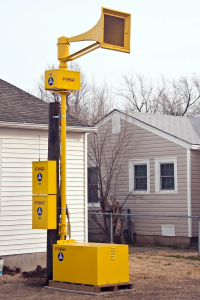 A privately owned Thunderbolt Model 1000T on display, complete with controls and 4M blower. | |
| Company | Federal Signal Corporation |
|---|---|
| Produced | 1952-1990/1992? |
| Type | Rotational Electromechanical (Model 1000, Model 1000T, Model 1003, System 7000)
|
| Sound output | 125-130 dB @ 100 ft |
| Frequency | 60 Hz |
| Horsepower | 2 hp |
| Voltage | 120/240/480 V 1 or 3 ph |
| Blower horsepower | 7.5 hp |
| Succeeded by | |
| Documentation | Manual |
The Thunderbolt was a long-running Series of supercharged rotating sirens manufactured by Federal Signal, and over its nearly 40-year production run it gained a reputation as one of the most popular civil defense sirens ever produced, sporting nearly unrivaled sound output when it was released, and continuing to be an incredibly popular siren until its discontinuation.
History
Federal Enterprises began production of the Thunderbolt Type 1000, a supercharged electromechanical rotating siren, in 1952. While most sirens are run on their own using air from the intake, the Thunderbolt was unique at the time for making use of a "Type 6M" supercharger in the form of a belt-driven Roots blower, which was changed many times throughout the siren's production. This would feed compressed air into the chopper, massively increasing the siren's sound output. This idea would be copied by ACA in 1968, with the introduction of their supercharged Hurricane 130. Contrary to popular belief, Federal never sued ACA for their similar design. The Model 2000 was released later in 1952 as a gas-powered variant of the Type 1000. While it was a good idea in concept, it was never popular due to the increased maintenance the engine required over a basic electric motor. Grid power was also widely available by the time the siren had released. They were mainly installed around California and Arizona. Due to the increased maintenance required as well as the impracticality of operating gasoline powered sirens today, only a few units remain, none operating on their engines. 2 of the surviving units were converted to electric motors for the blower, with one being in Phoenix, Arizona at Fire Station 22, and the other located at a school in Beebe, Arkansas, replacing a Whelen Engineering VORTEXR4 in 2019 that was struck and fried by lightning.
It is the last active Type 2000, although it is essentially now a Type 1000. There is only a single known Type 2000 with its original engine intact, which is located in Windsor Hills, CA. It was converted to propane at some point and is inactive and dilapidated like most of California's former civil defense siren systems. In 1954, the Model 2000 was discontinued, the "jail bar" horn reinforcements on Thunderbolt sirens were removed, and the Type 1000T was introduced. The Type 1000T originally used the 4/5-port dual tone rotor from a Model 2T; by 1959 5/6-port dual tone became the standard, with 4/5 being discontinued shortly after. Single-tone Thunderbolt sirens became known as the Type 1000. The Type 1000T became the standard model of Thunderbolt upon introduction, with the Type 1000 becoming optional. The Type 1000T was intended for civil defense purposes, while the Type 1000 was switched to being used for other purposes, though it could still be used as a civil defense siren if necessary. In 1959, the Type 1000 and Type 1000T began Series A2, a new Type 5M blower model was introduced, and Federal Signal introduced a 3-signal model known as the Type 1003. These were mainly meant for use in fire stations where the hi-lo signal would be used to separately warn of fire calls, since using the attack signal could cause confusion and panic.
The Type 1003 effectively replaced the Type 1000 for this purpose. The Type 4M blower began production in 1965, replacing the Type 5M. The Type 4M was created in an attempt to make the blower cheaper to produce, at the expense of sound output. All Thunderbolt nomenclature replaced "Type" with "Model" in 1975 when Federal Sign & Signal became Federal Signal. In 1981, Federal began Series B of the Thunderbolt sirens with a complete rotator overhaul in an attempt to make the sirens more maintenance-free. The Series B Thunderbolt sirens did not last long in production, as they ironically were less reliable than the standard models due to alignment problems burning the motors. In 1982, System 7000 was introduced, a line of self-contained versions of the Thunderbolt intended for use in areas where reliable power was unavailable like war zones or remote areas, and the Series B and Series B Model 4M blowers were discontinued and replaced by the Series C Thunderbolt models with new Series C Model 4M blowers (though the Series C Thunderbolt sirens commonly suffered from build quality issues). The latest Series B Thunderbolt sirens also made use of Series C blowers. The System 7000 sold very few units, most System 7026 units purchased by Kuwait during the Gulf War that have since been replaced by Federal Signal Modulator electronic sirens, some of which are mounted on top of the old enclosures. 1 System 7026 unit is confirmed to still exist, on display at the Kuwait National Office of Civil Defense.

In 1990, the Thunderbolt siren would finally be eliminated from Federal Signal's product line after a 38-year production run, as Federal's then-new 2001-SRN outperformed it without the need of a blower and also boasted a DC motor and battery backup capabilities. The last Thunderbolt sirens to be manufactured were a batch of Series C Model 1003 sirens sent to Michigan, though they have since been removed. Supposedly, there was a single year run in 1992 where Thunderbolt sirens were manufactured with a slightly shortened blower frame/cover; no known 1992 models are known to exist, and this information is unverifiable. The Thunderbolt is perhaps the most well-known of any American civil defense sirens, even with non-enthusiasts unfamiliar with sirens. Despite the Thunderbolt line's discontinuation, elements of its design still remain in Federal's 2001 Series and the 508-128 siren, with the 2001-SRN making use of the Thunderbolt rotator, and even today the collector ring tube from the Thunderbolt is still used in Federal's sirens even 30 years later. Many Thunderbolt sirens are still in service today, and while some have since been replaced by newer DC-capable sirens, many still continue to warn the public of danger.
Siren design
Model 1000
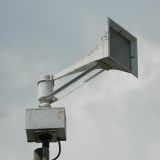
The Model 1000 (Type 1000 before 1975) is a single-tone, 2 signal supercharged electromechanical rotating siren. The Model 1000 utilizes a 2-piece cylindrical pivotal point which encloses the motor and rotor and supports the siren's large exponential horn alongside 2 supports attached below the motor tube (bottom piece). The siren's stator and motor are reused from the Model 2-240. Rather than using a typical stator, the Model 1000 makes use of a stator cap (upper piece) with a single port opening where the horn attaches to, focusing all of the siren's output through that port. Some of the earliest Type 1000 sirens came with a pressure release valve above the stator cap or downwards facing horns and an elongate stator cap. Early production Type 1000 sirens had 3 sets of steel reinforcements inside of the horn added by Federal Enterprises (nicknamed "jail bar" or "grid face" Thunderbolts by enthusiasts) as they feared the horn would warp and ruin the siren's sound output. A mesh screen was added inside the horn around 1953 to keep debris out and prevent the motor from burning. Federal experimented with horns that lacked the horn reinforcements, and the older horns were later discontinued in 1954 as the assembly without the reinforcements proved more than strong enough.
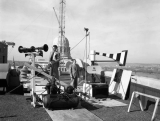
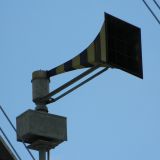
The siren's horn and rotor assembly are rotated using a belt-driven rotator inside of the box underneath the chopper tube, with collector rings inside the rotator allowing the siren to rotate 360°. The rotator is adjustable, with 3 different speeds: 2 rpm, 4 rpm, and 8 rpm. The vast majority of Model 1000 sirens are set to 2 rpm, with 4 rpm also being common while 8 rpm is much less common. Model 1000 sirens produced between 1981 and 1982 (Series B) use a motor turned 90 degrees to face the gear reducer coupled directly to the gear reducer instead of using a motor to drive a belt connected to a gear reducer to drive the rotator. These sirens could only rotate at 4 rpm, with the speed no longer being adjustable. These changes required the rotator box to be enlarged and offset from the siren's horn instead of being directly in the middle underneath and necessitated the use of external wiring to the chopper motor. The chopper motor itself was placed inside of a cylindrical cover. Series B was superseded by Series C in 1982, which returned to the previous belt-driven rotator and the previous unenclosed universal motor.
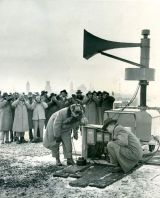
These Series C models often suffered from issues stemming from poor build quality. The Model 1000 came in 1 and 3 ph variants, the Model 1000B and Model 1000A respectively. The Model 1000 is supercharged with what is known as a Roots blower. A Roots blower has 2 sets of lobes inside of a steel container (which is perfectly rectangular on production models, although earlier variants of the siren used rounded containers) which compress and supercharge the air flowing into it as they spin against one another, which is then piped up into the siren itself, massively increasing the siren's volume and range. These blowers were produced by Sutorbilt. The blowers take in air from above through a dedicated intake, and the lobes are driven by 3 belts and a 1 or 3 ph 7.5 hp electric motor. The siren's main pipe includes a pressure release valve beside the blower; this helps prevent the air pressure from blowing holes in the standpipe, destroying the chopper, or potentially exploding in the event of a blockage. A Model 1000 without a blower is effectively a Model 2 with a horn attached and inferior airflow, and as such Model 1000 sirens are quiet and high pitched without them.
Blowers are only designed to spin one way, and if wired backwards (reverse wiring, possible on 3 ph Model 1000A sirens only) the blower will run in reverse, sucking air from the siren's horn and out of the blower. This results in the siren becoming very high pitched, and the blower becomes significantly louder, often nearly drowning out the siren itself because of this. This also causes the siren to have a near nonexistent winddown, as the air pressure causes the chopper to quickly come to a stop when the motor shuts off, and a slow extended windup as the chopper fights the airflow. The Model 1000 reaches 126 dB at 100 ft according to Federal Signal; however, the decibel rating of these sirens varies depending on the blower used. Typically, the higher air pressure created by the blower, the louder the siren will be.
Model 1000T
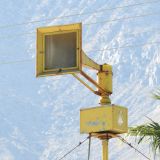
The Model 1000T (Type 1000T before 1975) is a dual-tone, 2 signal supercharged electromechanical rotating siren. The Model 1000T utilizes a 2-piece cylindrical pivotal point which encloses the motor and rotor and supports the siren's large exponential horn alongside 2 supports attached below the motor tube (bottom piece). The siren's stator and motor are reused from either the 4/5-port or 5/6-port Model 2T-240. Rather than using a typical stator, the Model 1000T makes use of a stator cap (upper piece) with a single port opening where the horn attaches to, focusing all of the siren's output through that port. The siren's horn and rotor assembly are rotated using a belt-driven rotator inside of the box underneath the chopper tube, with collector rings inside the rotator allowing the siren to rotate 360°. The rotator is adjustable, with 3 different speeds: 2 rpm, 4 rpm, and 8 rpm. The vast majority of Model 1000T sirens are set to 2 rpm, with 4 rpm also being common while 8 rpm is much less common. Model 1000T sirens produced between 1981 and 1982 (Series B) use a motor turned 90 degrees to face the gear reducer coupled directly to the gear reducer instead of using a motor to drive a belt connected to a gear reducer to drive the rotator. These sirens could only rotate at 4 rpm, with the speed no longer being adjustable.
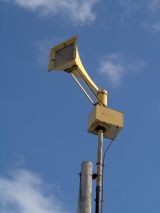
These changes required the rotator box to be enlarged and offset from the siren's horn instead of being directly in the middle underneath and necessitated the use of external wiring to the chopper motor. The chopper motor itself was placed inside of a cylindrical cover. Series B was superseded by Series C in 1982, which returned to the previous belt-driven rotator and the previous unenclosed universal motor. These Series C models often suffered from issues stemming from poor build quality. The Model 1000T came in 1 and 3 ph variants, the Model 1000BT and Model 1000AT respectively. The Model 1000T is supercharged with what is known as a Roots blower. A Roots blower has 2 sets of lobes inside of a steel container (which is perfectly rectangular on production models, although earlier variants of the siren used rounded containers) which compress and supercharge the air flowing into it as they spin against one another, which is then piped up into the siren itself, massively increasing the siren's volume and range. These blowers were produced by Sutorbilt. The blowers take in air from above through a dedicated intake, and the lobes are driven by 3 belts and a 1 or 3 ph 7.5 hp electric motor.
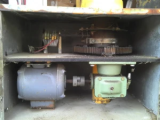
The siren's main pipe includes a pressure release valve beside the blower; this helps prevent the air pressure from blowing holes in the standpipe, destroying the chopper, or potentially exploding in the event of a blockage. A Model 1000T without a blower is effectively a Model 2T with a horn attached and inferior airflow, and as such Model 1000T sirens are quiet and high pitched without them. Blowers are only designed to spin one way, and if wired backwards (reverse wiring, possible on 3 ph Model 1000AT sirens only) the blower will run in reverse, sucking air from the siren's horn and out of the blower. This results in the siren becoming very high pitched, and the blower becomes significantly louder, often nearly drowning out the siren itself because of this. This also causes the siren to have a near nonexistent winddown, as the air pressure causes the chopper to quickly come to a stop when the motor shuts off, and a slow extended windup as the chopper fights the airflow. The Model 1000T reaches 124 dB at 100 ft according to Federal Signal; however, the decibel rating of these sirens varies depending on the blower used. Typically, the higher air pressure created by the blower, the louder the siren will be.
Model 1003
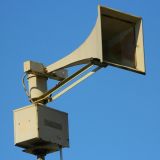
The Model 1003 (Type 1003 before 1975) is a dual-tone, 3 signal supercharged electromechanical rotating siren. The Model 1003 utilizes a 2-piece cylindrical pivotal point which encloses the motor and rotor and supports the siren's large exponential horn alongside 2 supports attached below the motor tube (bottom piece). The siren's stator and motor are reused from either the 4/5-port or 5/6-port Model 2-240. Rather than using a typical stator, the Model 1003 makes use of a stator cap (upper piece) with a single port opening where the horn attaches to, focusing all of the siren's output through that port. The Model 1003 utilizes a solenoid operated mechanism in front of the stator cap which blocks 1 of the 2 ports in the horn—or both if desired—allowing for the siren to perform a "hi-lo" or "pulse" signal. The Model 1003 horn is slightly elongated and moved forwards to make way for the solenoid mechanisms. The return springs on the solenoids are prone to failure, with many units suffering from one or both solenoids failing to operate due to the springs wearing out. The siren's horn and rotor assembly are rotated using a belt-driven rotator inside of the box underneath the chopper tube, with collector rings inside the rotator allowing the siren to rotate 360°. The rotator is adjustable, with 3 different speeds: 2 rpm, 4 rpm, and 8 rpm. The vast majority of Model 1003 sirens are set to 2 rpm, with 4 rpm also being common while 8 rpm is much less common. The rotator box on the Model 1003 is enlarged to make room for the additional collector rings that were needed to run the solenoids. Also included with the Model 1003 would be a specialized Model RCM3 controller, which allowed for individual control of all components. Model 1003 sirens produced between 1981 and 1982 (Series B) use a motor turned 90 degrees to face the gear reducer coupled directly to the gear reducer instead of using a motor to drive a belt connected to a gear reducer to drive the rotator.
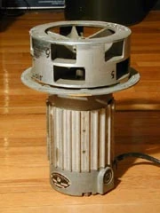

These sirens could only rotate at 4 rpm, with the speed no longer being adjustable. These changes required the rotator box to be enlarged and offset from the siren's horn instead of being directly in the middle underneath and necessitated the use of external wiring to the chopper motor. The chopper motor itself was placed inside of a cylindrical cover. Series B was superseded by Series C in 1982, which returned to the previous belt-driven rotator and the previous unenclosed universal motor. These Series C models often suffered from issues stemming from poor build quality. The Model 1003 came in 1 and 3 ph variants, the Model 1003B and Model 1003A respectively. The Model 1003 is supercharged with what is known as a Roots blower. A Roots blower has 2 sets of lobes inside of a steel container (which is perfectly rectangular on production models, although earlier variants of the siren used rounded containers) which compress and supercharge the air flowing into it as they spin against one another, which is then piped up into the siren itself, massively increasing the siren's volume and range. These blowers were produced by Sutorbilt. The blowers take in air from above through a dedicated intake, and the lobes are driven by 3 belts and a 1 or 3 ph 7.5 hp electric motor. The siren's main pipe includes a pressure release valve beside the blower; this helps prevent the air pressure from blowing holes in the standpipe, destroying the chopper, or potentially exploding in the event of a blockage. A Model 1003 without a blower is effectively a Model 2T with a horn attached and inferior airflow, and as such Model 1003 sirens are quiet and high pitched without them.
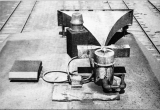
Blowers are only designed to spin one way, and if wired backwards (reverse wiring, possible on 3 ph Model 1003A sirens only) the blower will run in reverse, sucking air from the siren's horn and out of the blower. This results in the siren becoming very high pitched, and the blower becomes significantly louder, often nearly drowning out the siren itself because of this. This also causes the siren to have a near nonexistent winddown, as the air pressure causes the chopper to quickly come to a stop when the motor shuts off, and a slow extended windup as the chopper fights the airflow. 2 Model 1003 units were adapted for use as train horns, by means of removing the rotator, and adding a flatter, wider projector as opposed to the regular Thunderbolt horn. It is believed that they were supercharged by pneumatics provided from the locomotive itself. This setup was placed atop EMD DDA40X locomotives operated by the Union Pacific Railroad numbers 6918 and 6924. Another unit, EMD SDP35 number 1400, was also eventually equipped with one of these. These sirens were paired with standard locomotive air horns and were used only for emergency purposes such as clearing a visible obstruction on the tracks. It is speculated that both solenoids are shut by default and are both opened when the siren is activated. The Model 1003 reaches 124 dB at 100 ft according to Federal Signal; however, the decibel rating of these sirens varies depending on the blower used. Typically, the higher air pressure created by the blower, the louder the siren will be.
Type 2000
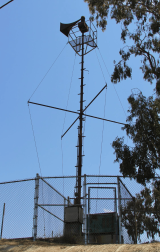
The Type 2000 is a dual-tone, 2 signal supercharged gas-powered rotating siren. The Type 2000 utilizes a 2-piece cylindrical pivotal point which encloses the motor and rotor and supports the siren's large exponential horn alongside 2 supports attached below the motor tube (bottom piece). The siren's stator and motor are reused from the Model 2-240. Rather than using a typical stator, the Type 2000 makes use of a stator cap (upper piece) with a single port opening where the horn attaches to, focusing all of the siren's output through that port. Most Type 2000 sirens have 3 sets of steel "jail bar" reinforcements inside of the horn added by Federal Enterprises as they feared the horn would warp and ruin the siren's sound output. The siren's horn and rotor assembly are rotated using a belt-driven rotator inside of the box underneath the chopper tube, with collector rings inside the rotator allowing the siren to rotate 360°. The rotator is adjustable, with 3 different speeds: 2 rpm, 4 rpm, and 8 rpm. The Type 2000 came in 1 and 3 ph variants, although all units are simply stamped with "Type 2000". The Type 2000 utilizes a Series A1 Type 6M supercharger with what is known as a Roots blower. A Roots blower has 2 sets of lobes inside of a steel container which compress and supercharge the air flowing into it as they spin against one another, which is then piped up into the siren itself, massively increasing the siren's volume and range. These blowers were produced by Sutorbilt.

The blowers take in air from above through a dedicated intake, and the lobes are driven by 3 belts. The siren's main pipe includes a pressure release valve beside the blower; this helps prevent the air pressure from blowing holes in the standpipe, destroying the chopper, or potentially exploding in the event of a blockage. A Type 2000 without a blower is effectively a Model 2 with a horn attached and inferior airflow, and as such Type 2000 sirens are quiet and high pitched without them. Rather than using an electric motor, the siren's blower is powered by an Onan twin-cylinder gasoline engine. This engine also served as a generator for the siren, allowing it to operate independently of external power sources, which was important for areas where grid power was either unreliable, or would be in danger of being lost in an attack. Blowers are only designed to spin one way, and if wired backwards (reverse wiring, possible on 3 ph Type 2000 sirens only) the blower will run in reverse, sucking air from the siren's horn and out of the blower. This results in the siren becoming very high pitched, and the blower becomes significantly louder, often nearly drowning out the siren itself because of this. This also causes the siren to have a near nonexistent winddown, as the air pressure causes the chopper to quickly come to a stop when the motor shuts off, and a slow extended windup as the chopper fights the airflow. The Model 2000 reaches 129 dB at 100 ft.
System 7000
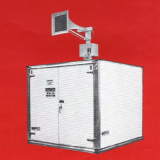
System 7000 is a line of dual or single-tone, 2 or 3-signal supercharged electromechanical/gas-powered rotating sirens. The blower and controls were enclosed inside a large enclosure which also housed a large gasoline-driven AC generator which would be used to power the siren. These were introduced sometime in the 1980s for use in areas where reliable power was unavailable, such as war zones or remote areas. The siren would be driven by standard mainline power when available, switching to the generator when power failed. The enclosure is weather, corrosion and heat resistant, with cooling fans allowing it to operate even in hot, hostile environments. It is also tamper-resistant to prevent vandalism or unauthorized activations, and includes a security system that activates an alarm in the event of somebody breaking in. The System 7000 came with Model 1000, Model 1000T and Model 1003 heads, known as the System 7012, System 7022, and System 7026 respectively. Most known units were System 7026 units in service in Kuwait during the Gulf War and have all since been replaced by Federal Signal Modulator electronic sirens, some of which are mounted on top of the old enclosures. 1 System 7026 unit is confirmed to still exist, on display at the Kuwait National Office of Civil Defense.
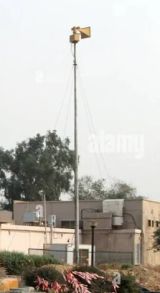
The System 7000 utilizes a 2-piece cylindrical pivotal point which encloses the motor and rotor and supports the siren's large exponential horn alongside 2 supports attached below the motor tube (bottom piece). The siren's stator and motor are reused from the Model 2-240 (System 7012) or either the 4/5-port or 5/6-port Model 2T-240 (System 7022 and System 7026). Rather than using a typical stator, the System 7000 makes use of a stator cap (upper piece) with a single port opening where the horn attaches to, focusing all of the siren's output through that port. The System 7026 utilizes a solenoid operated mechanism in front of the stator cap which blocks 1 of the 2 ports in the horn—or both if desired—allowing for the siren to perform a "hi-lo" or "pulse" signal. The System 7026 horn is slightly elongated and moved forwards to make way for the solenoid mechanisms. The return springs on the solenoids are prone to failure, with many units suffering from one or both solenoids failing to operate due to the springs wearing out. The siren's horn and rotor assembly are rotated using a belt-driven rotator inside of the box underneath the chopper tube, with collector rings inside the rotator allowing the siren to rotate 360°. The rotator is adjustable, with 3 different speeds: 2 rpm, 4 rpm, and 8 rpm. The rotator box on the System 7026 is enlarged to make room for the additional collector rings that were needed to run the solenoids. Also included with the System 7026 would be a specialized controller, which allowed for individual control of all components, and a 6 signal variant of the AF timer named the Model AF*22Z.
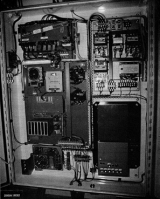
The System 7000 came in 1 and 3 ph variants, with all units stamped with either Model 1000A/B, Model 1000A/BT, or Model 1003A/B. The System 7000 is supercharged with what is known as a Roots blower. A Roots blower has 2 sets of lobes inside of a steel container (which is perfectly rectangular on production models, although earlier variants of the siren used rounded containers) which compress and supercharge the air flowing into it as they spin against one another, which is then piped up into the siren itself, massively increasing the siren's volume and range. These blowers were produced by Sutorbilt. The blowers take in air from above through a dedicated intake, and the lobes are driven by 3 belts and a 1 or 3 ph 7.5 hp electric motor. The siren's main pipe includes a pressure release valve beside the blower; this helps prevent the air pressure from blowing holes in the standpipe, destroying the chopper, or potentially exploding in the event of a blockage. A System 7000 without a blower is effectively a Model 2T with a horn attached and inferior airflow, and as such System 7000 sirens are quiet and high pitched without them.
Blowers are only designed to spin one way, and if wired backwards (reverse wiring, possible on 3 ph System 7000 sirens only) the blower will run in reverse, sucking air from the siren's horn and out of the blower. This results in the siren becoming very high pitched, and the blower becomes significantly louder, often nearly drowning out the siren itself because of this. This also causes the siren to have a near nonexistent winddown, as the air pressure causes the chopper to quickly come to a stop when the motor shuts off, and a slow extended windup as the chopper fights the airflow. The blower and controls of all System 7000 sirens are enclosed inside a large enclosure which also housed a large gasoline-driven AC generator used to power the siren. The siren is driven by standard mainline power when available, switching to the generator when power failed. The enclosure is weather, corrosion and heat resistant, with cooling fans allowing it to operate even in hot, hostile environments. It is also tamper-resistant to prevent vandalism or unauthorized activations and includes a security system that activates a buzzer and strobe outside the enclosure in the event of somebody breaking in; a key has to be turned to disarm the alarm. Both high and low mounted System 7000 configurations were offered. The System 7012 reaches 127 dB at 100 ft, while the System 7022 and System 7026 reach 126 dB at 100 ft.
Blower design
Type 6M (Series A1)
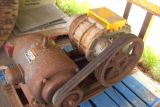
The Type 6M (Series A1) blowers had a 6-inch diameter pipe with a sound pressure of 300 CFM and uses a much larger pulley driven at a slower speed than other blowers, which results in a pulsating sound for both the blower itself and the siren. This is especially noticeable on single tone units. Due to their age, 6M blowers are less common than the other blower models. Due to the lower sound pressure caused by the larger pipe, these tend to be slightly quieter than other blowers, though the pulsating effect helps mitigate this by being more attention grabbing. Single tone units are rated at roughly 129 dB on a 6M blower, while dual tone units are rated at 128 dB.
Type 5M (Series A2)
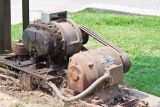
The Type 5M (early Series A2) is generally regarded as the loudest and punchiest of the blowers. These blowers made use of a much smaller pulley with a 3-diameter pipe, which allowed a pressure of 350 CFM. Because of this change, Thunderbolt sirens running on 5M blowers tend to be very punchy due to the additional air pressure, especially the Model 1000. These blowers lack the pulsating effect of the 6M, instead having a low-pitched hum with a bit of a hiss. The increase in air pressure allows the siren to boast a rating of 130 dB on single tone units, and 129 dB on dual tone units.
Model 4M (Series A2, Series B)
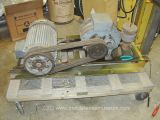
The Model 4M (Type 4M before 1975, late Series A2 and Series B) uses a 1.5-inch diameter pipe, alongside a slightly smaller blower, which results in an air pressure of 250 CFM. These blowers are the most common blowers found on Thunderbolt sirens and can be visually identified from other blowers as the Model 4M blower introduced a vent on the rear of the blower box. However, some early Type 4M blower boxes lack these vents. These blowers have a loud, high-pitched hum, and run at a faster speed than the other blowers due to the smaller pulley. These blowers are far less punchy than the Type 5M and Type 6M and instead have more of a "buzzy" sound to them. They're still very loud however, with single tone units being rated at 127 dB at 100 ft, while dual tone units are rated at 126 dB.
Model 4M (Series C)
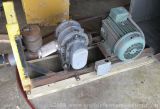
The Series C Model 4M blower is essentially a Series A2 Model 4M blower flipped onto its side into a vertical position. On Series C Model 4M blowers, the pulley sizes are slightly larger on the blower compared to the motor. This causes the blower to run at a slower speed. Instead of the pipe being located below the blower, the pipe is mounted to the side of the blower, which causes the standpipe to be higher up on the blower box compared to earlier Thunderbolt models. The pressure release valve is also significantly enlarged. Supposedly, there was a single year run in 1992 where Thunderbolt sirens were manufactured with a slightly shortened blower frame/cover; no known 1992 models are known to exist, and this information is unverifiable.